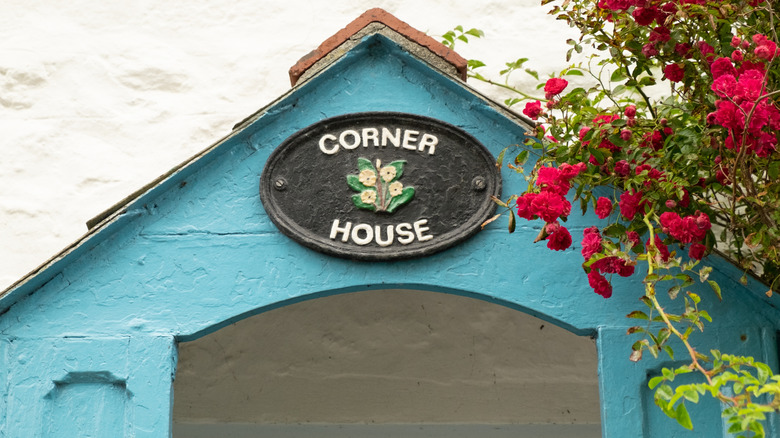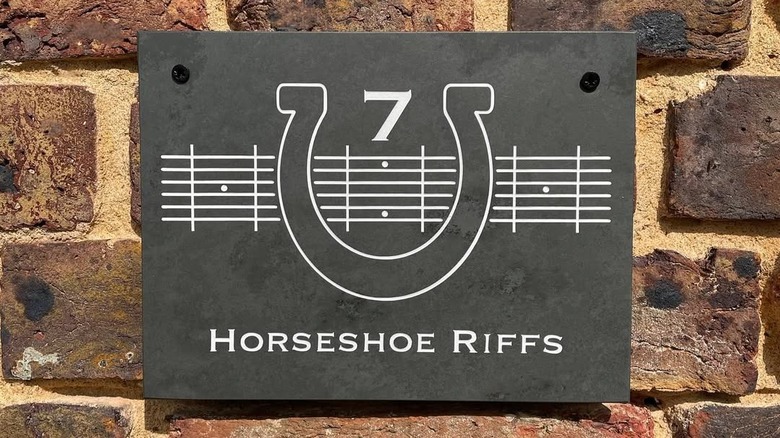Monograms Might Be Out - But Some Are Embracing A New Trend: The Bespoke Home Logo
Your great-grandparents would get the electric mower, and maybe even the robotic mower. They'd probably be able to understand your minimalism if you make room for a pickle shelf. And while they certainly would have understood your modern monogrammed decor, they might need a little time to understand why your home would need its own logo.
The rise of the bespoke home logo required a strange confluence of cultural factors, including personal branding, social media positioning, and maybe a little virtue signaling or outright pride. Giving your home a name is a far older tradition, as you might have noticed if you've ever stayed in an individually owned mountain or beach house, which was probably called something like Above It All or Latitude Adjustment. More luxe homes might have slightly less cutesy names.
There are dozens of reasons people might want logos for their homes. Perhaps the most obvious is Airbnb properties; while it's not a must-have for an Airbnb host, it's certainly a natural fit. Some people have homesteads or organic hobby farms. Other are just looking for a use, probably involving Etsy, for that Creality laser engraver they bought last year. What they all have in common is a need, or at least a desire, to differentiate themselves and their homes from others.
The evolving style of home logos
Stylistically, home logos probably evolved from the hipster logos of the 2010s– the ones that all look like an X peppered with letters and clip art. By the rise of the sharing economy in the post-COVID U.S., the logos have evolved a bit, keeping that stamped quality but losing the X and clipart in favor of illustration. Ivy Odom, whose own personal brand might be described as "Steel Magnolias" with a dash of prep school or L'Academie de Cuisine, sees the home logo as a replacement for monograms — those three-initial embroideries that were difficult to read and impossible to understand the point of that probably needed replacing.
As they morphed into more traditional branding, logos acquired a bit more clarity than monograms ever possessed. And bespoke personal logos do the same thing for you that your home logo does for your house, whatever that is. All of these types of logos, whether they're for yourself, your for-rent guest room, or your Jimmy Buffet cover band, are still all sort of similar: minimalist, vintage-y, with handwritten or script wordmarks that aren't always that different from monograms. Some of the best look like nothing so much as a firemark, a metal plaque commonly found above historic homes' front doors.
One more thing: you might want to give your home a name that represents it memorably. "Creekside Cottage" or "Ivy Inn" might work, or you could add a touch of reality to your Airbnb pitch with "Mortgage Manor."
How to make a home logo without a marketing company
Branding always seems fun to anyone who hasn't had to develop a corporate brand manual, and personal branding has a lot in common with (and is a lot more fun than) company branding. It promotes an advantageover competitors, builds credibility, and generates opportunities. All of which is to say that a personal or home logo makes people believe in you, and perhaps willing to send money your way. The process is also familiar to anyone who's endured the corporate version: define your goals, do exhaustive research related to your audience and competitors, identify what makes you unique, and develop a branding strategy that ties all of those things together. And don't forget the value proposition.
Once you have all that, or at least a brief, AI-friendly query you can paste into a website, you're ready to have your logo created. Your options range from real people "powered by AI" on sites like fiverr to AI-driven logo-generation websites like Canva and Looka to freelance designers from sites like Upwork who use AI tools in Photoshop and Illustrator to build custom logos. You can even pit designers from around the world against each other in a logo contest using a crowdsourcing service like DesignCrowd.
Then you have the problem of what to do with your logo. Corporations buy branded merchandise in quantity from specialized providers, but companies like Vistaprint and Shutterfly can help you use your home logo on branded coffee cups or mouse pads on a more human scale.

